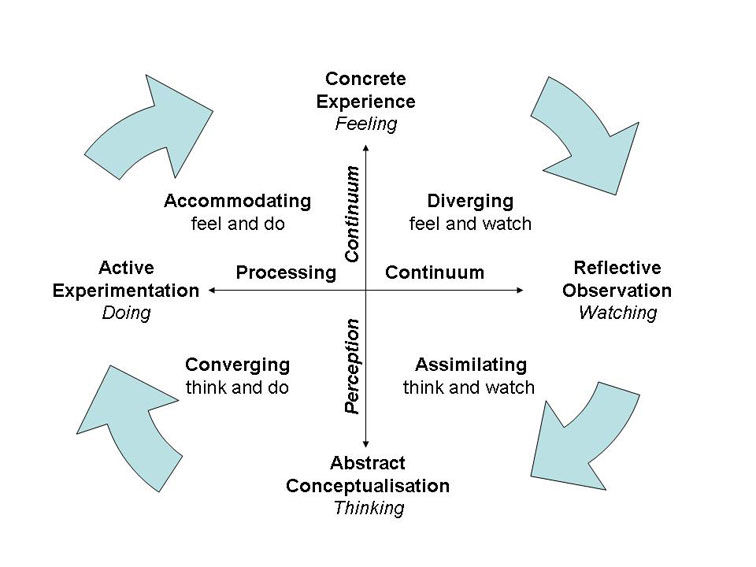When we teach English we need to consider many things: students’ needs, motivation, learners’ styles, their preferences. There are several models, theories and tests that we can use to identify and research learners’ style:
- Kolb and Honey & Mumford’s learning style model
- Leicester University’s Honey and Mumford
- Hong Kong Polytechnic Learning Styles
- Gardner’s Multiple Intelligence Test
- VAK Learning Styles Test
In this article, I’ll have a look at Kolb’s four types of learner.

Kolb’s learning theory is a theory developed by David Kolb. Kolb was inspired by the works of German-American psychologist, Kurt Lewin. Kolb published his model in 1984. “Kolb’s experiential learning theory works on two levels: a four-stage cycle of learning and four separate learning styles” © Wikipedia.
What are these four types?
- Diverging: Feeling and Watching.
- Assimilating: Watching and Thinking.
- Converging: Doing and Thinking.
- Accommodating: Doing and Feeling.
What does each learner type stand for?
- Diverging (feeling and watching).
These students prefer to watch rather than do, they listen to others first and then state their opinion. They are quite sensitive. They are usually strong in Arts. They prefer group work. They learn best when they observe, when they have quiet thinking time. They’ll learn less if they need to lead an activity or role-play in front of the group, when they have no preparation time. They usually don’t like timings.
2. Assimilating (watching and thinking).
These students are analytical and they like a logical approach. For them, ideas and concepts are more important than people. They would value a good clear explanation more than practice. They like brainstorming ideas. They need enough time to do tasks. They like well-structured, clear situations, problems and purposes. They need to try to probe the ideas. They don’t like tasks where there’s an emphasis on feelings, unstructured activities. It’s hard for them to collaborate with students who are very different from them. They like individual work
3. Converging (doing and thinking).
These students prefer technical tasks and are less concerned with people. They use their learning to find solutions to practical problems. The ability to apply new knowledge to their job is crucial for them. They like to try out new ideas, concepts, things to work with practical applications. They like when there’s a model they can copy. They’d complain if they don’t see how they can apply what they’ve learned right away and there are no guidelines on how to do things. These students always need feedback.
4. Accommodating (doing and feeling).
These are hands-on students. They rely more on intuition rather than instruction. They prefer practical and experimental approaches. They prefer to work in teams. They are open-minded, open to new ideas and experiences. They like working with others, they like difficult tasks. These students like to lead discussions. They don’t like lectures, long explanations, working on their own; analysing information on their own; following instructions. They are usually impatient, bossy, impulsive. They may not want to collaborate at times that can cause conflict. They are fast finishers and want to be leaders.
What types of tasks fit these learners? Some examples
- Diverging (feeling and watching).
Writing short reports, online research, tasks that put their imagination at work (e.g., write a story, draw and write). Some CLIL: learning English through music, Art, etc.
2. Assimilating (watching and thinking).
Individual work activities (e.g., controlled practice tasks — gap-fill exercises), problem-solving activities, guided discoveries.
3. Converging (doing and thinking).
Role-play they can apply and use at their jobs; case studies that include real problems and students can put them into practice; task-based activities; competitive games.
4. Accommodating (doing and feeling).
Ice-breakers, debates, games, case studies and discussion they can lead.
As you can see, you can use this theory to find an individual approach to the students, to develop necessary learning opportunities, to design activities that suit learners’ styles.






 Вероника Аветисян
Вероника Аветисян 
 Маргарита Аветисян
Маргарита Аветисян 


